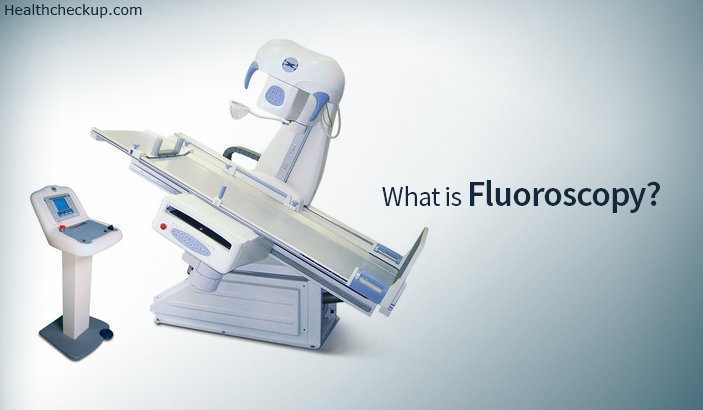What is Fluoroscopy?
The study of moving body structures which are alike an X-ray movie is called as Fluoroscopy. Here, the body which needs to be examined receives X-ray beam. The beam is diffused to a TV-like monitor in order to see in detail the body parts and also its motion. Fluoroscopy, which acts as an imaging tool, lets doctors to see at many body systems, comprising the digestive, skeletal, urinary, reproductive, and respiratory systems.
Fluoroscopy may be done to assess specific areas of the bodythat includes muscles, the bones, and joints, also the solid organs, like heart, kidneys or lung.
Additional associated procedures which might be used to identify issues of the muscles, bones, or joints such as myelography, X-rays, magnetic resonance imaging (MRI), arthrography and computed tomography (CT scan).
Reasons for a Fluoroscopy – Why is a Fluoroscopy done?
Fluoroscopy is used in many types of investigations and procedures, like cardiac catheterization, barium X-rays, arthrography, placement of intravenous (IV) catheters, lumbar puncture, intravenous pyelogram, biopsies and hysterosalpingogram.
Fluoroscopy might be used as a diagnostic process, or might be used in combination with other diagnostic or therapeutic procedures or media.
In barium X-rays, fluoroscopy when is used alone permits the physician to see the intestine movement as the barium transfers through them and permits the physician to the patient position for spot imaging. In cardiac catheterization, fluoroscopy is used as an assistant to allow the doctor to see the blood flow via the coronary arteries in order to appraise the incidence of arterial blockages. On behalf of intravenous catheter insertion, fluoroscopy supports the physician in managing the catheter into anexact location inside the body.
Fluoroscopy Uses also Include, which are not Limited to, the Following:
- Tracing foreign bodies
- Image-guided anesthetic injections into spine or joints
- Percutaneous vertebroplasty which is a minimally invasive technique used to treat compression fractures of the spinevertebrae. Other reasons can also be a possibility as directed by your physician.
Risks of Fluoroscopy
You might want to ask your physician regarding the radiation amount used in the course of the risks and procedure associated to your specific situation. Generally, it is a better idea to maintain a record of your radiation exposure past history, like earlier scans and other kind of X-rays, so that you can notify your physician. Risks related with radiation exposure might be associated to the increasing number of X-ray treatments or examinations over an extensive period of time.
If you are pregnant or expecting pregnancy then you should inform your doctor. Radiation exposure in pregnancy might cause birth defects in the baby.
If there is use of contrast dye then there might be a risk of allergic reaction because of dye. Patients who are sensitive or allergic to medications, iodine, contrast media, or latex mustalert their physician. Also, patients with kidney failure or kidney related problems then shouldtell their physician.
Few factors or issues may obstruct with the exactness of a fluoroscopy procedure. For example, a recent barium X-ray procedure might restrict with exposure of the lower back or abdomen area.
There might be additional risks which depends on your definite medical problem. Always one needs to be sure to talk over any concerns with your physician before the procedure.
Medically appropriate fluoroscopy tests gives clinical benefits which over shadow the risk from the radiation received in the tests. Radiology examinations when done by highly trained technologists, board certified radiologists, fluoroscopic tests give considerable diagnostic use to patients and is influential in managing treatment plans. Patients and parents of pediatric patients to talk with their personal doctor and also with their radiologist regarding the tests.
Food and Drug Administration (FDA) regulates all fluoroscopy machines and must see exact standards to be measured effective and safe.
Examinations Included in the use of Fluoroscopy:
- Enteroclysis
- Barium enema
- Myelogram
- Barium swallow
- Lumbar puncture
- Upper gastrointestinal series
- Interventional radiology procedures
- Small bowel series
- Interventional neuroradiology procedures
What Happens During the Fluoroscopy Procedure?
Fluoroscopy might be done on an outpatient basis or also as a part of your stay in a hospital. Procedures may differ depending on your problem and your physician’s practices.
The patient will be requested to remove any jewellery or clothing which might cause obstruction with the exposure of the body area to be inspected. Gown will be given to wear.
A contrast substance might be given, which depends on the procedure type that is going to be performed, through enema, swallowing, or an intravenous (IV) line in your arm or hand.
The patient will be positioned on the X-ray table. With the type of procedure, the patient might be asked to take on different positions, change an exact body part, or to hold the breath during intervals although the fluoroscopy is being performed.
The procedures which need catheter insertion, like catheter placement or cardiac catheterization into a joint or other body part, an extra insertion line site might be used in the elbow, groin, or other site.
A special X-ray machine would be used to form the fluoroscopic images of the body structure being treated and examined.
A dye or contrast substance might be injected into the IV line site for better visualization of the organs or structures that is being studied.
With arthrography which is a joint visualization, any fluid in the joint may be aspirated before the injection of the contrast substance. After the injection of contrast, the patient might be asked to move the joint for a few minutes to consistently distribute the contrast substance all the way through the joint.
The length of procedure is usually determined by the type of test, body type treated or examined. Once the procedure has been completed, they will remove the IV line.
Although fluoroscopy alone is not painful, the specific procedure being performed might be painful, like the joint injection or gaining access to an artery or vein for angiography. In these circumstances, the radiologist will take all comfort methods possible that could comprise conscious sedation, local anesthesia, or general anesthesia, which depends on the specific procedure.
Results of Fluoroscopy
- The doctor will carefully study the images and video of the test results for presence of any abnormality
- If in case any abnormalities are noted, then appropriate treatment will be recommended.
- There are few cases wherein additional tests are requested to rule out any other problems
Medically Reviewed By

I am an experienced Medical/Scientific writer with a passion for helping people live a happy healthy life. My thirst for writing has followed me throughout the years – it is there when I wake up, lingering at the edges of my consciousness during the day, and teases me at night as I go to sleep.









